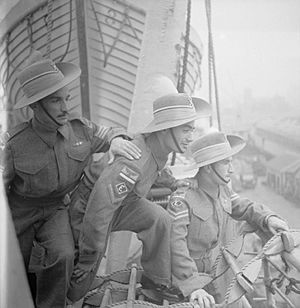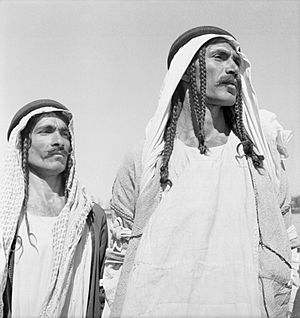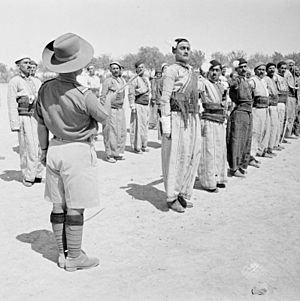Iraq Levies facts for kids
Quick facts for kids Assyrian Levies |
|
|---|---|

Three members of the RAF Levies arrive at Liverpool aboard SS Orbita in 1946.
|
|
| Active | 1921–1955 |
| Country | Iraq |
| Allegiance | United Kingdom |
| Branch | British Army Royal Air Force |
| Type | Air force |
| Size | 40,000 Assyrians |
| Nickname(s) | Assyrian Levies |
| Engagements | Mahmud Barzanji revolts Kirkuk Massacre of 1924 World War II • Anglo-Iraqi War Ahmed Barzani revolt Simko Shikak revolt (1918–1922) Simko Shikak revolt (1926) |
| Commanders | |
| Notable commanders |
Dawid Mar Shimun Agha Petros Malik Khoshaba Malik Yaqo Zaia Giwargis |
The Assyrian Levies were a special military group formed by the British in Iraq between 1921 and 1955. They were also known as the Iraq Levies. This force was the first local army set up in Iraq when it was under British control.
The Levies started as a group of Arab scouts during World War I. Later, when Iraq became a British Mandate (meaning Britain helped govern it), the group mostly included Assyrians, Kurds, and Iraqi Turkmen. These groups lived in the northern parts of Iraq. The main job of the Levies was to protect the northern borders of the Mosul area. After 1928, they mainly guarded the Royal Air Force (RAF) bases in Iraq.
The Levies showed great bravery during the Anglo-Iraqi War in May 1941. They also helped in other parts of World War II after 1942. The force grew bigger and stayed active until 1955. They were disbanded when the RAF bases at RAF Habbaniya and RAF Shaibah were given back to Iraq.
Contents
History of the Levies
The story of the Iraq Levies began in 1915 during World War I. A British officer named Major J. I. Eadie created a group called the Arab Scouts. He recruited about 40 mounted Arabs to protect British political officers in southern and central Iraq. By 1918, this group had grown to include over 5,000 Arabs, Kurds, Turkomans, Marsh Arabs, and Assyrians.
At its peak, around 40,000 Assyrians served in the Levies.
Becoming the Iraq Levies
In 1919, the force changed its name twice. First, it was called the Militia, and then in July, it became the Iraq Levies. This happened when Iraq officially became a British Mandate. The Levies were divided into a main fighting force and a district police force.
At the Cairo Conference in 1921, leaders decided the Levies' main goal. They were meant to replace British and Indian troops in Iraq. They would take over guard duties and fill the gap until Iraq could train its own national army.
Assyrians Join the Force
Before 1921, the Levies were mostly made up of Arabs, Kurds, and Turcomans. But when the Iraqi Army was formed, Arabs and other Muslim people were asked to join that new army instead. So, it was decided to recruit mostly Assyrians for the Levies.
The British highly valued Assyrians for their discipline, loyalty, and fighting skills. Assyrians were Christians who spoke Eastern Aramaic. They were a minority group in Iraq, which was mostly Arab and Kurdish Muslim. A treaty in 1922 allowed the Levies to continue. It said they were "members of the British Forces who are inhabitants of Iraq."
By 1923, about half of the Iraq Levies were Assyrian. There were also many Kurds, a battalion of Marsh Arabs, and some Armenians, Mandeans, and Turcomans. In 1928, the Levies became fully Assyrian. Their main job was to protect the Royal Air Force bases in Iraq. They were sometimes called "Shabanas," a Turkish word for a semi-military police force.
The Assyrians were very disciplined and loyal to their British officers. For example, in 1920, Assyrian camps were attacked by Arab forces, but the Assyrians successfully defended themselves.
Challenges in the 1930s
In 1931, the Levies and Iraqi army units were patrolling the Barzan district. In 1932, many Levies threatened to quit. They felt that Britain had not done enough to secure the future of the Assyrian people after Britain's control over Iraq ended.
British troops from Egypt had to come in to take over guard duties. Assyrian leaders asked the Levies to keep serving until the League of Nations could respond to their concerns. Most of the Levies returned to duty, but about 250 men were discharged.
World War II and Beyond
During the Battle of Habbaniya in 1941, the RAF base was surrounded by the Iraqi Army. The Levies, along with other units, helped lift the siege. After this, the Levies recruited 11,000 more men, mostly Assyrians, but also some Kurds and Yezidi.
By 1942, the Iraq Levies had a headquarters, a training depot, and many companies. They even had a Parachute Company, which was 75% Assyrian and 25% Kurd. In 1943, the Levies had 166 British officers and 44 companies. Twenty-two of these were Assyrian, and others were mixed Assyrian/Yizidi, Kurdish, and Marsh Arab.
Some Assyrian companies served in Palestine and Cyprus. The Parachute Company worked with the Royal Marine Commando and fought in Albania, Italy, and Greece. In 1943-1944, the Iraq Levies were renamed the Royal Air Force Levies.
After World War II in 1945, the Levies became much smaller. The RAF Regiment took over command. In 1946, the Levy battalions were renamed to fit the RAF Regiment's system.
The End of an Era
The RAF Levies continued their guard duties until 1954. By then, they had about 1,200 Assyrians, 400 Kurds, and 400 Arabs. The RAF Levies were officially disbanded on May 2, 1955. King Faisal was there as the RAF bases at Habbaniya and Shaibah were given back to the Iraqi Government.
Some Assyrians from the Levies joined the Iraqi Army. On May 3, 1955, Iraqi Army guards took over from the Levies. This marked the end of the Assyrian Levies. The British offered money, job training, and help for the Levies to start new civilian lives. Those who had served for 15 years or more received pensions.
Levy Ranks and Uniforms
The officers in the Levies had special ranks based on ancient Assyrian military titles:
- Rab Khaila: This meant "force leader."
- Rab Tremma: This meant "leader of 200."
- Rab Emma: This meant "leader of 100."
- Rab Khamshi: This meant "leader of 50."
For most of their history, the Levies wore standard British tropical uniforms. After 1943, they used RAF rank badges. A unique part of their uniform was a slouch hat with the brim turned up, like the Australian style. For parades, they wore a white feather plume on their hats.
Medals Awarded to the Levies
Members of the Assyrian Levies received many awards for their bravery and service.
Cross of Saint George
In 1917, during World War I, the Russian Empire awarded the Cross of St. George to eight Assyrian members.
Order of the British Empire
Ten Orders of the British Empire were given to officers of the Iraq Levies. This included both the OBE and MBE awards.
Military Cross
The Military Cross was awarded to several personnel for their bravery in battle.
Military Medal
The Military Medal was also awarded to members of the Levies for their courage.
Mentioned in Dispatches
Six members of the Iraq Levies were Mentioned in Dispatches. This means their brave actions were officially recognized in military reports.
Medal for Long Service and Good Conduct
Over 300 Medals for Long Service and Good Conduct were given to members who served for more than fifteen years.
King George Medal with Clasp
Many King George Medals with Clasp were awarded in 1922 for operations in the Rawanduz area of Northern Iraq.
General Service Medal with Iraq Clasp
The General Service Medal for Iraq was created in 1924. It was awarded to the Levies by King Faisal I for their actions in Iraq between 1924 and 1936.
World War Two Medals
Members of the Iraq Levies received three different medals for their service in World War II:
- The War Medal 1939–1945: Awarded after 28 days of service.
- The 1939-1945 Star: Awarded after six months of service.
- The Italy Star: Given to parachute company members who served in Albania, Italy, or Greece.
See also
- RAF Iraq Command
- RAF Habbaniya
- RAF Shaibah
- Kirkuk Massacre of 1924
- Simele massacre
- Iraqforce
For similar units see:
- Mesopotamia Rifles
- Aden Protectorate Levies
External links
- Assyrian battle of Albania at YouTube
- A comprehensive website on the Assyrian RAF Levies
- RAF Habbaniya Association website



